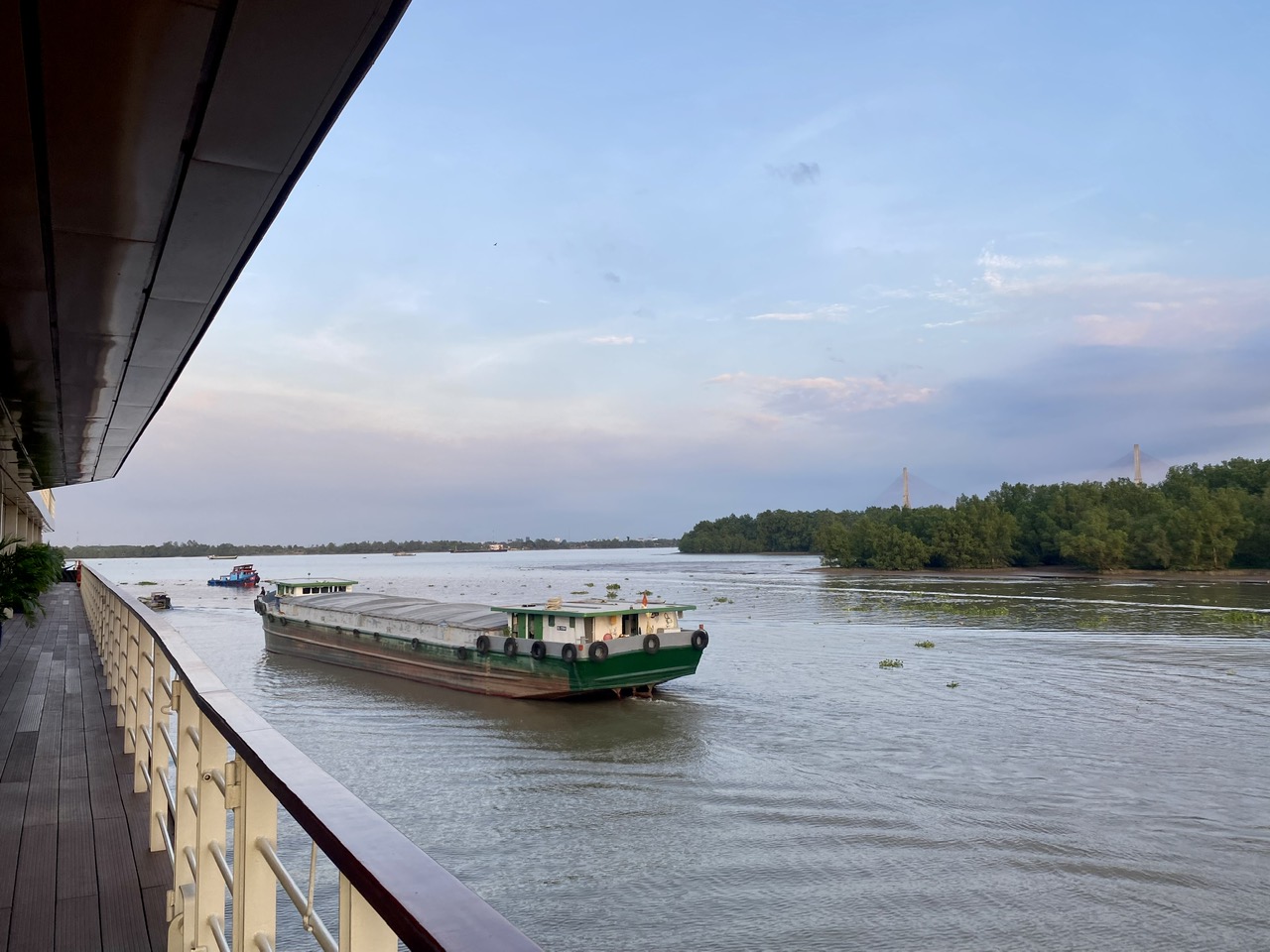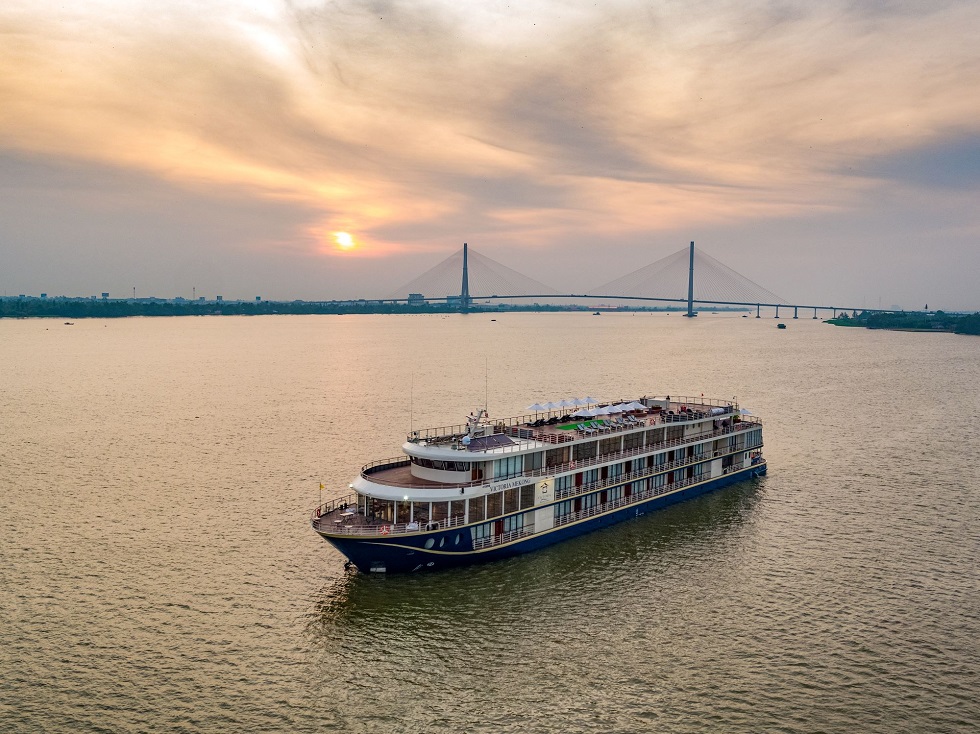The Mekong Delta, with its extensive web of rivers and canals, holds immense potential as a tourism hotspot and eagerly awaits exploration. Yet, as the promise of this “gold mine” remains untapped, the pressing question arises as to how the regional gem can be polished and effectively attract visitors.
This daunting task was at the heart of the talk show titled “Tapping the ‘gold mine’ of water tourism in the Mekong Delta”, organized by the Saigon Times Group as part of the Safe Destination program. The event, in collaboration with Thien Minh Group (TMG), was held on December 20 aboard the Victoria Mekong cruise in Can Tho City.
Challenges persist amid river charms
Interlacing canals offer a distinct advantage for tourism development in the Mekong Delta. Phan Dinh Hue, director of Viet Circle Travel Service Company Limited, said, “The geographic condition characterized by numerous rivers makes it a valuable resource for the tourism industry.” Hue noted that the region is situated in a basin renowned worldwide for its legendary river, the Mekong, which makes it stand out from both central and northern Vietnam.

For travelers, the bustling daily life along the rivers in the Mekong Delta holds an irresistible allure, with its diversification adding an additional layer of regional fascination. From fishing to agricultural cultivation, local communities flourish on the abundance of natural resources provided by the river. It also serves as a picturesque setting for the lively festivities of the Hoa, Cham, and Khmer ethnic groups. Hue highlighted the region’s potential as a lucrative “gold mine” for tourism with a broad range of enticing features such as river tours, water sports, and riverside resorts and hotels.
The Mekong Delta’s tourism development is facilitated by a year-round sunny environment, which proves to be advantageous for various tourist activities. The rivers also have calm waters without any significant waves or rapids, which greatly ensures safe navigation.
To Linh Da, head of MICE Tourism and Corporate Clients at Image Travel & Events, said the pastoral charm and distinct landscapes of the region—such as the iconic coconut palms in Ben Tre Province and cork trees in Soc Trang Province—are key attractions for travelers. This HCMC-based business specializes in tour operations for French visitors.
“In addition to aesthetically pleasing aspects, river excursions offer visitors the chance to observe the daily lives along the rivers and immerse themselves in the local culture,” she said, adding that tourists appreciate the sight of bicycles traversing village paths.
However, it is essential to recognize the prevailing limitations in tourism growth in the Mekong Delta. Hue argued that disparities in waterborne transportation infrastructure hinder the effective development of tourism offerings. “In the Mekong Delta, there is only one fully functional and adequate cruise ship port located in My Tho City, Tien Giang Province. In contrast, other areas in the region have makeshift ports that lack the necessary infrastructure and are of inferior quality,” he added.
Additionally, the absence of internationally renowned festivals along the Mekong River, combined with the increasing number of dam construction on its tributaries, poses a considerable challenge to river navigation and impedes the potential growth of river tourism.
Cruise tourism in the spotlight
Amid the looming concerns about underutilized potentials of the Mekong Delta, Thien Minh Group (TMG)’s succesful operation of cruise trips within the region, even extending into Cambodia, shines as a bright spot.
Vo Xuan Thu, TMG Cluster general manager of the Mekong Delta, highlighted the company’s aim to offer captivating experiences to guests and foster interactions with local communities at every destination, utilizing existing resources. “This is how we showcase the Delta’s culture, history, and traditional crafts,” she said.
The pillars of TMG’s operation are laid on three captivating water-based tourist areas: Can Tho City, Cai Be District in Tien Giang Province, and Chau Doc City in An Giang Province. Of them, the Victoria Mekong Cruises has emerged as a prominent river tourist service in Can Tho City. In a fleet of over 20 vessels currently navigating the Mekong River, the Victoria Mekong was the first to sail the Hau River section that runs between the cities of Can Tho and Long Xuyen, passing through Vam Nao and Tan Chau, before merging with the Tien River and continuing its course towards the Cambodian capital of Phnom Penh, added Thu, who is also general manager of the Victoria Can Tho Resort.

In just four years of operation this service, TMG has successfully developed a loyal clientele, resulting in a nearly fully booked itinerary until 2024, excluding scheduled maintenance periods. Next year, an eight-day, seven-night journey will take travelers from Can Tho to the captivating destinations of Phnom Penh and Kampong Cham Province in Cambodia.
In addition to foreign clients, Thu said that the company’s main priority is on catering to high-end local passengers. “We are prepared to design tailor-made tours with specific timetables for organizations, companies, or corporate retreats serving groups of up to 100 participants,” she added.
Tourism branding is a must
During the talk show, experts emphasized the need to create a captivating brand for regional tourism. The growing influence of ecotourism means that water-based tours, which are closely connected to nature, will attract a large number of tourists.
To maximize the potential of river tourism, Linh Da said organizers need to pay attention to four main factors: tailored itineraries, nature-connected facilities, professional staff, and captivating cuisine.

When planning an itinerary, in particular, it is important to cater to the guests’ desire to make the most of their experience. Restaurants, boats, and hotels in the Mekong Delta are encouraged to maintain a close connection with nature, allowing visitors to immerse in the regional beauty. These establishments also need to showcase and integrate the distinctive architectural elements of the region into their projects. To achieve a high level of professionalism, staff members need to undergo thorough training in effective communication and appropriate behavior. Last but not least, the menu should be customized to the guests’ preferences and requirements.
Assoc. Prof. Dr. Le Anh Tuan, former deputy director of the Research Institute for Climate Change (DRAGON-Mekong Institute) at Can Tho University, emphasized the importance of making the attractions of the regional “gold mine” visible to all, rather than hidden away. “To achieve this objective, individuals employed within the tourism industry should possess a high level of professionalism and expertise,” he added.
He said river tourism in the Mekong Delta necessitates not only showcasing the physical attributes of the river and the region’s attractions, but also imparting to visitors the true spirit of the region. This involves clarifying aspects such as the distinctive qualities of the river in comparison to others, as well as the development of urban areas and the functioning of floating markets. Collaboration from all relevant stakeholders will be necessary for this effort.
Tuan stressed the need of having knowledgeable experts who possess a deep understanding of the culture and can provide comprehensive insights into the rivers and water of the Mekong Delta. This, he believes, is crucial for tour guides to effectively comprehend and convey the relevant information to visitors.
Hue highlighted a significant issue plaguing the Mekong Delta’s tourism industry—the absence of a unified brand to leverage its potential. Surprisingly, while the term “Mekong Delta” has become a recognized brand in other countries, it fails to serve as a cohesive identity within the region itself. He suggested integrating a localized branding element into the overall marketing strategy.
According to experts, when it comes to harnessing the advantages of rivers and water for long-term development, organizers must prioritize sustainability in tourism. This entails offering products and activities that are environmentally friendly, preserve local cultural identity and heritage, and contribute to the economic growth of the community.









